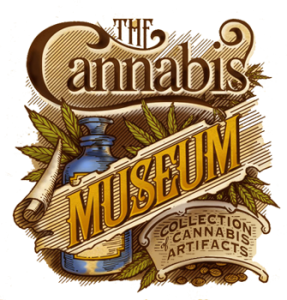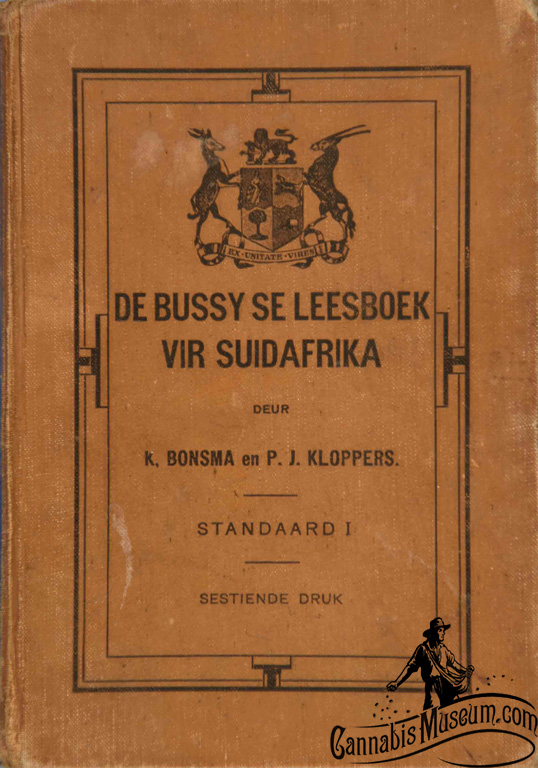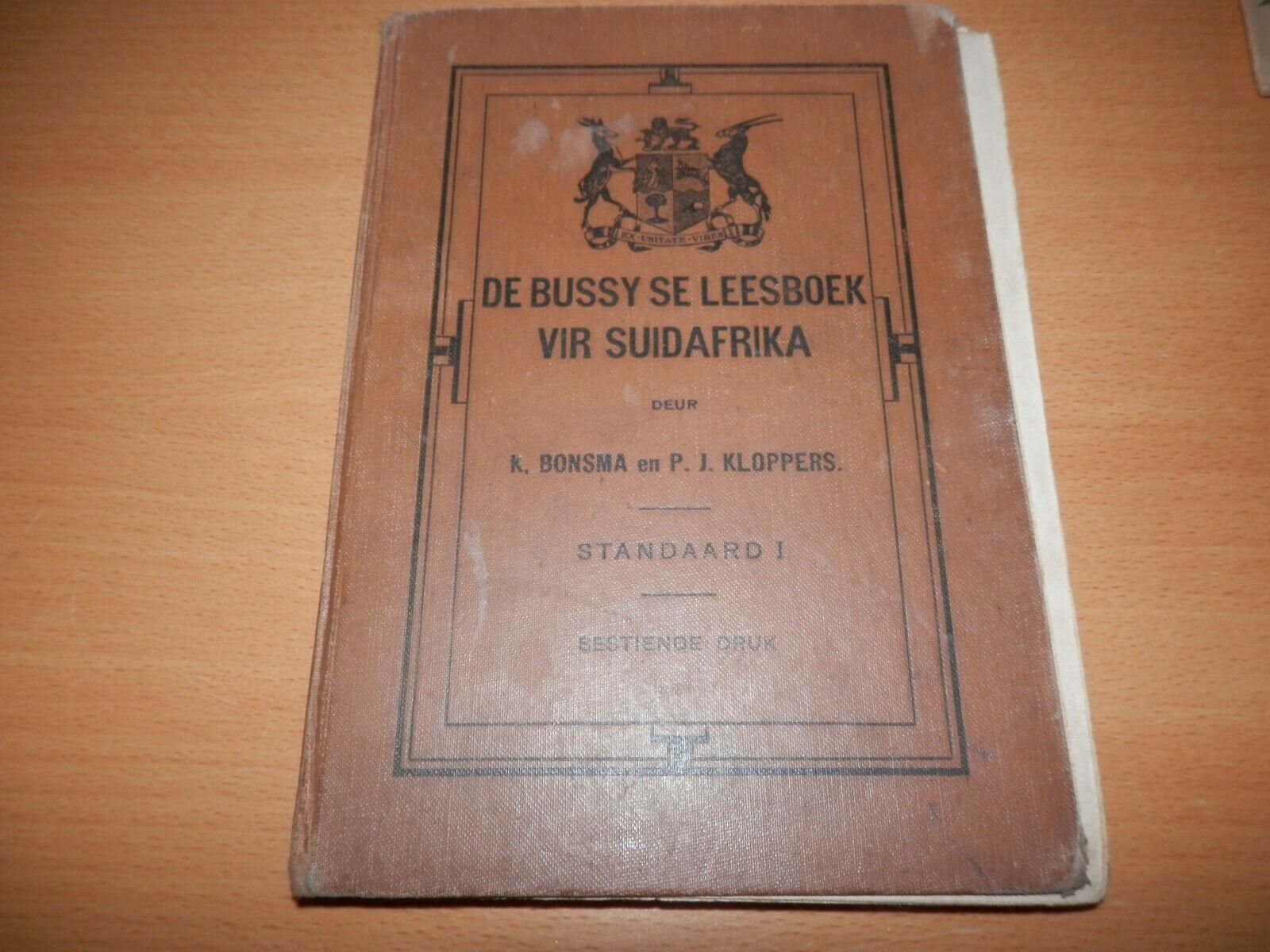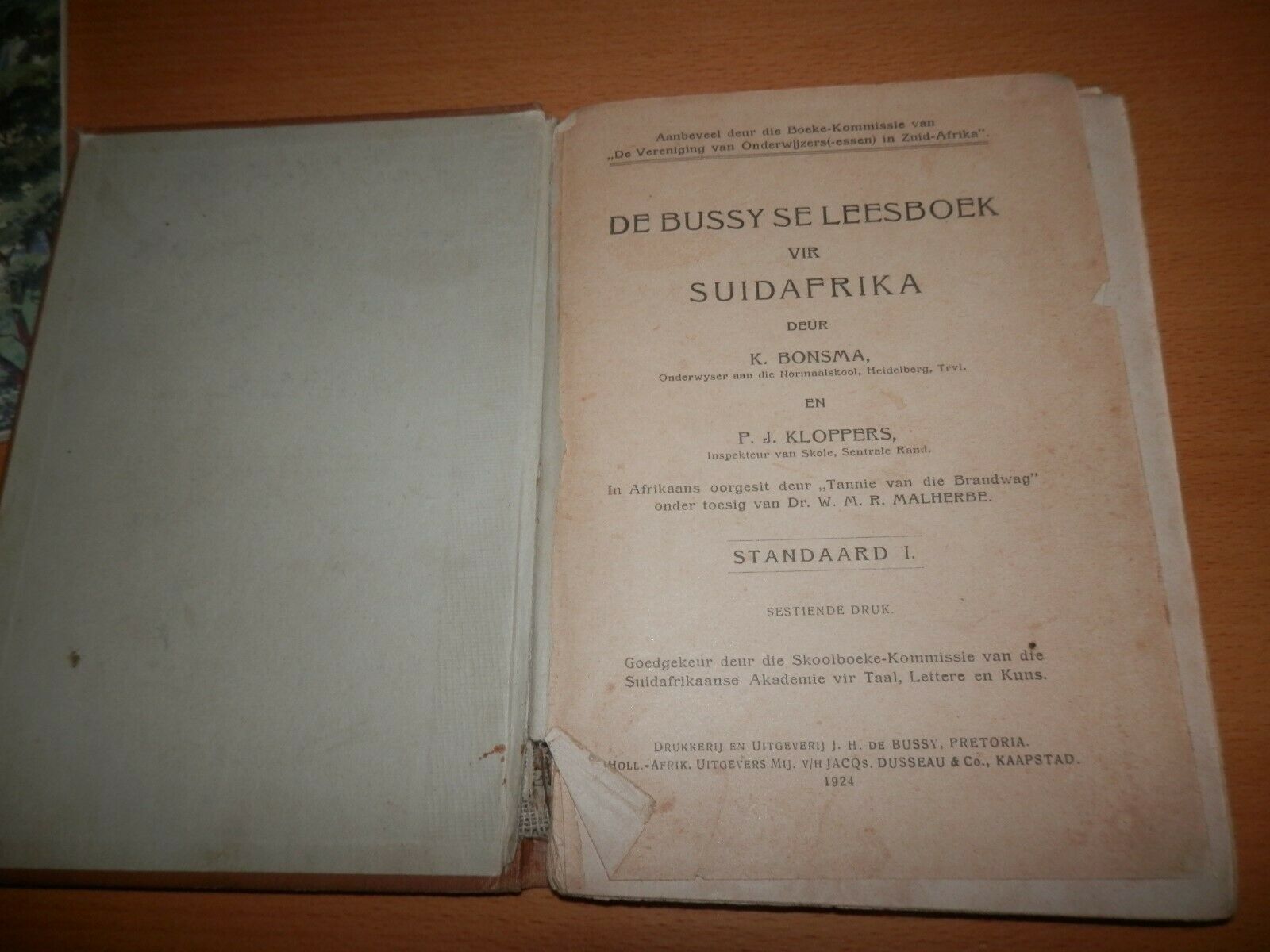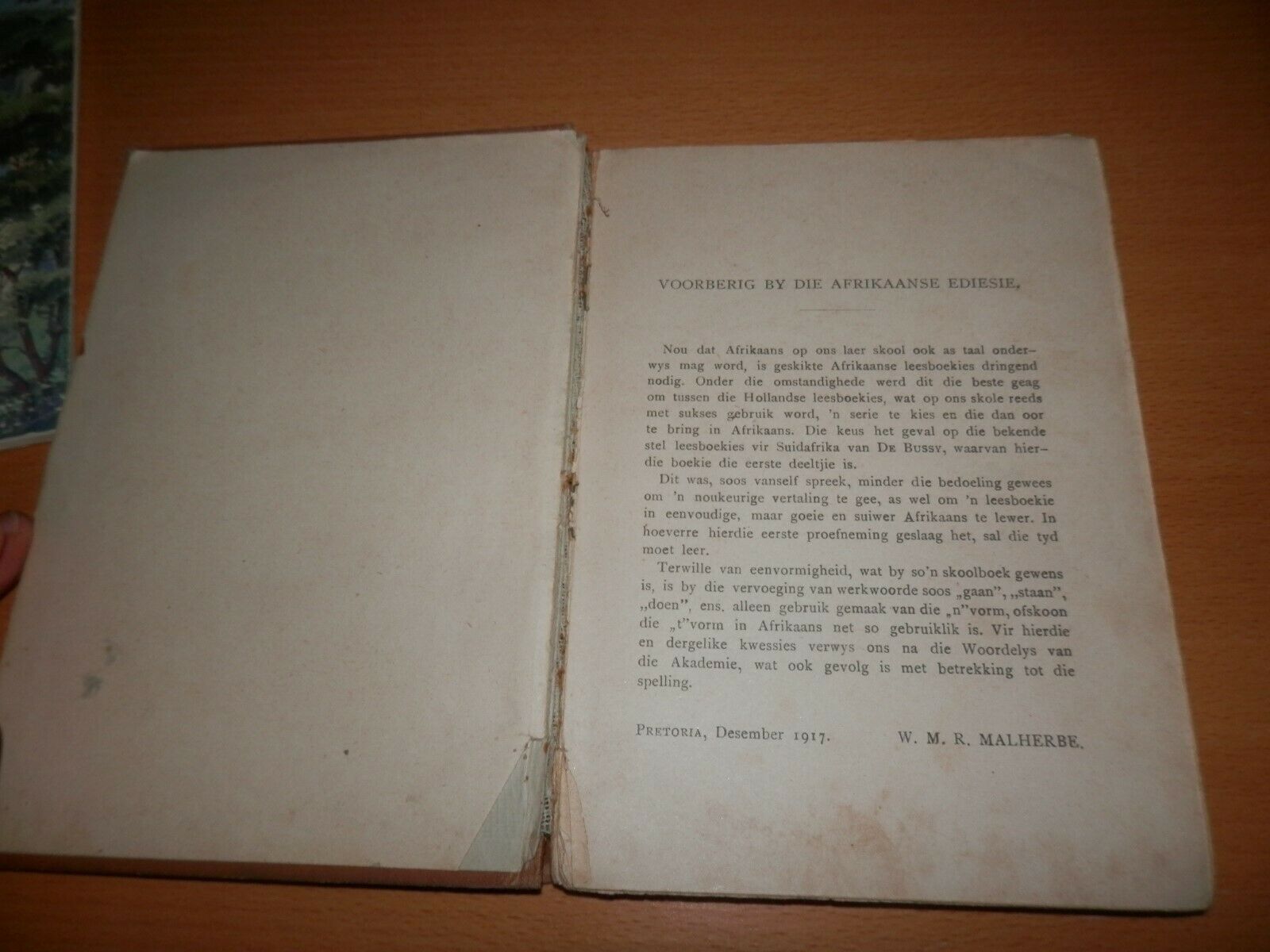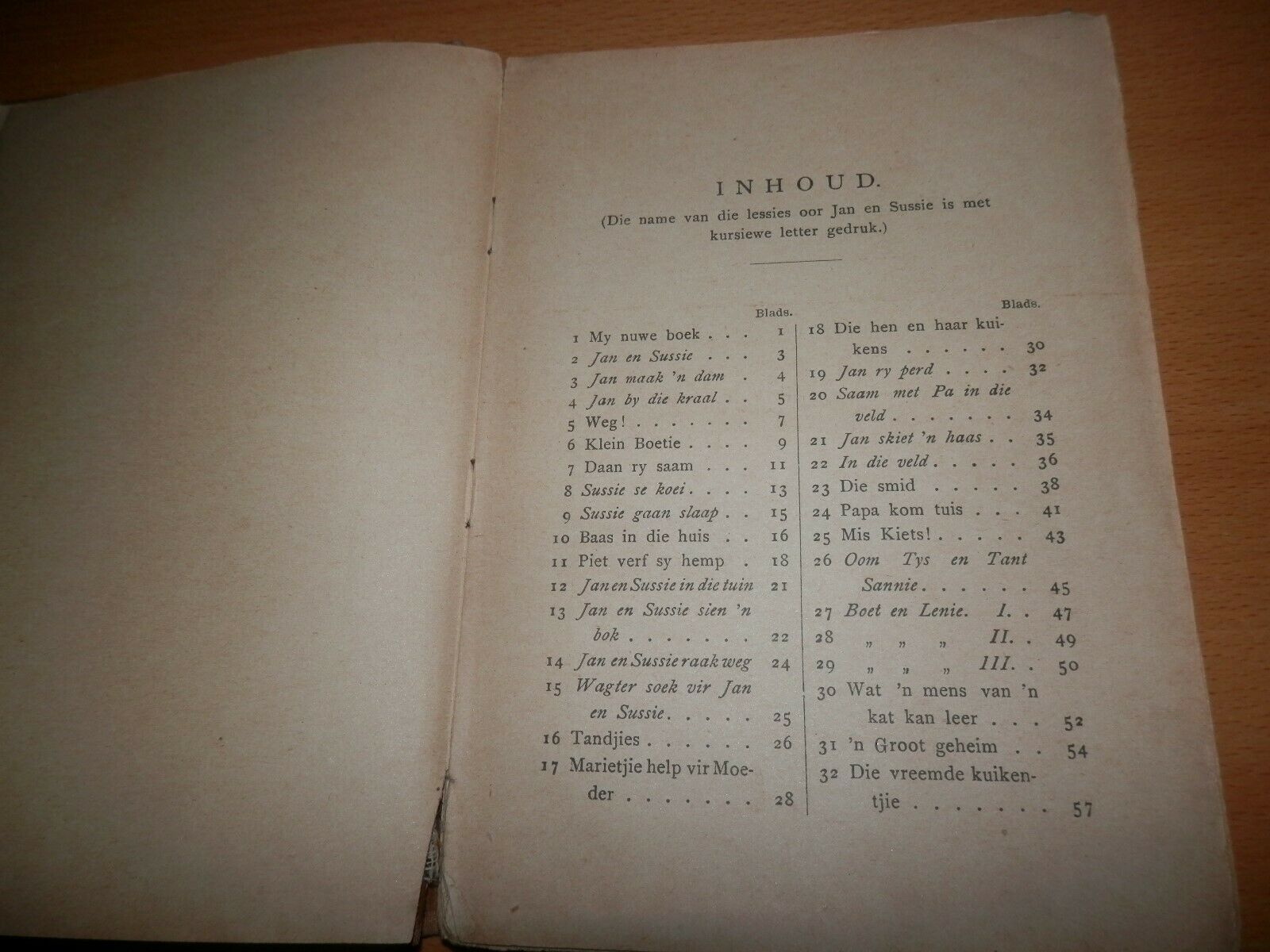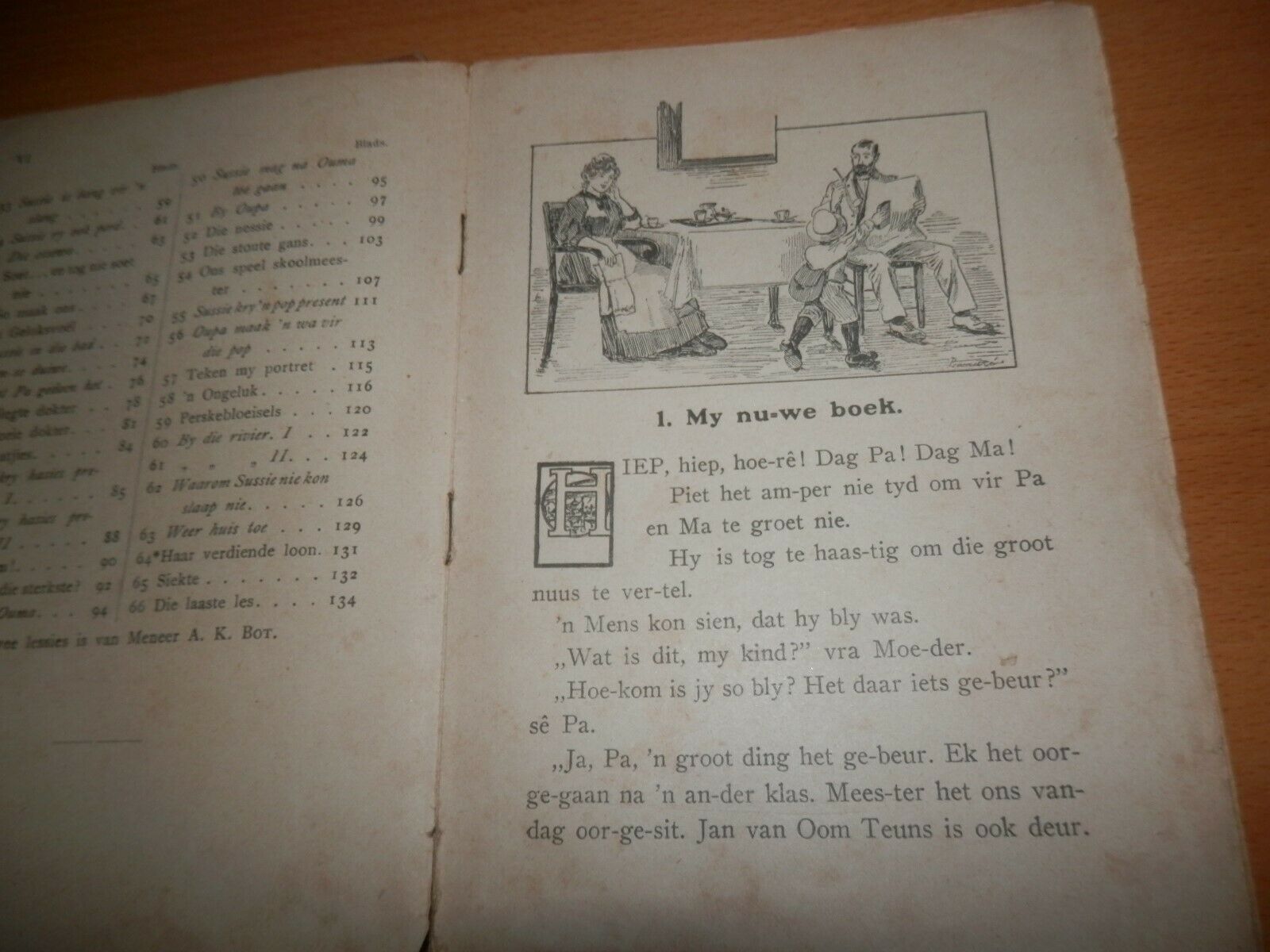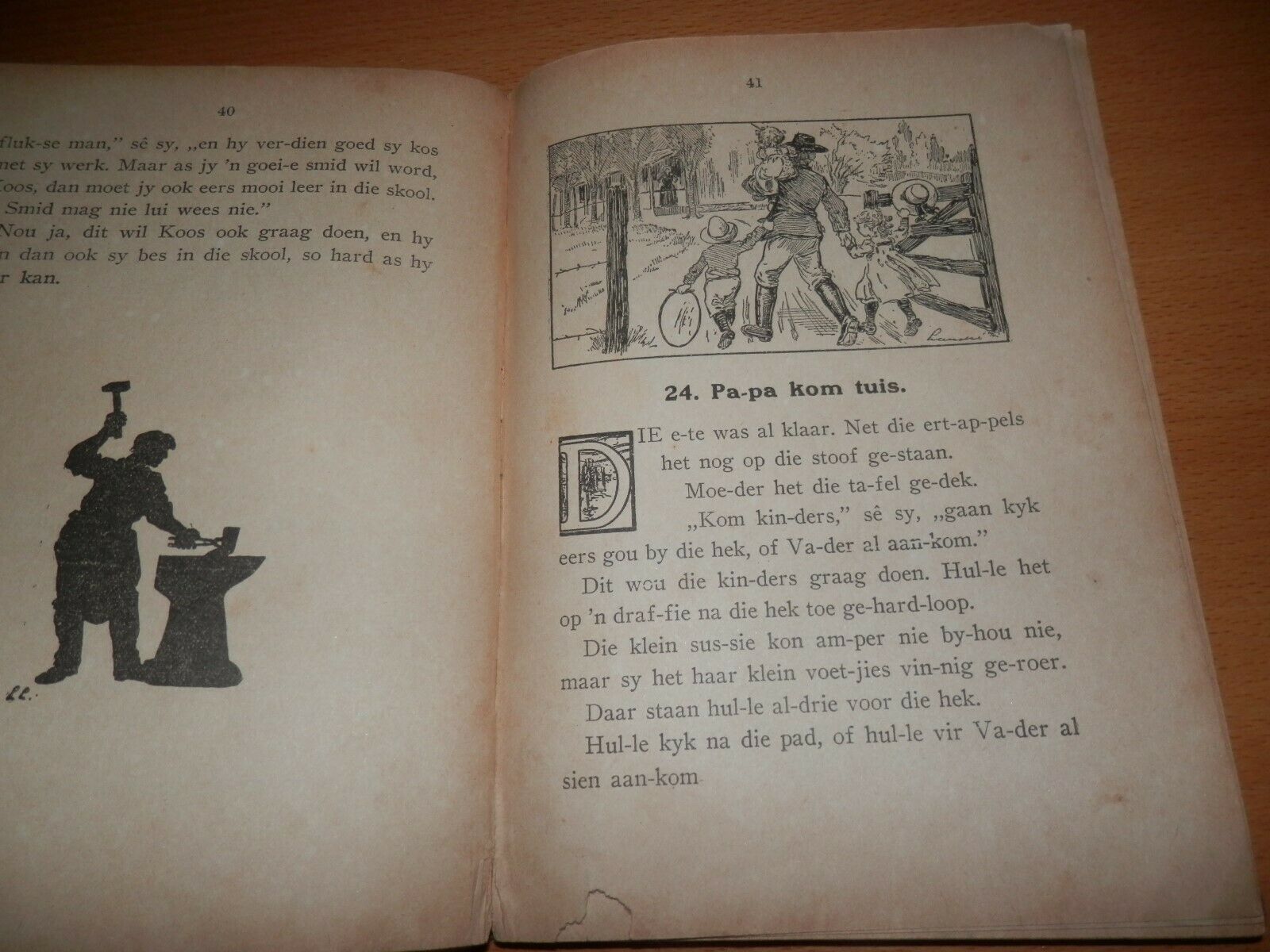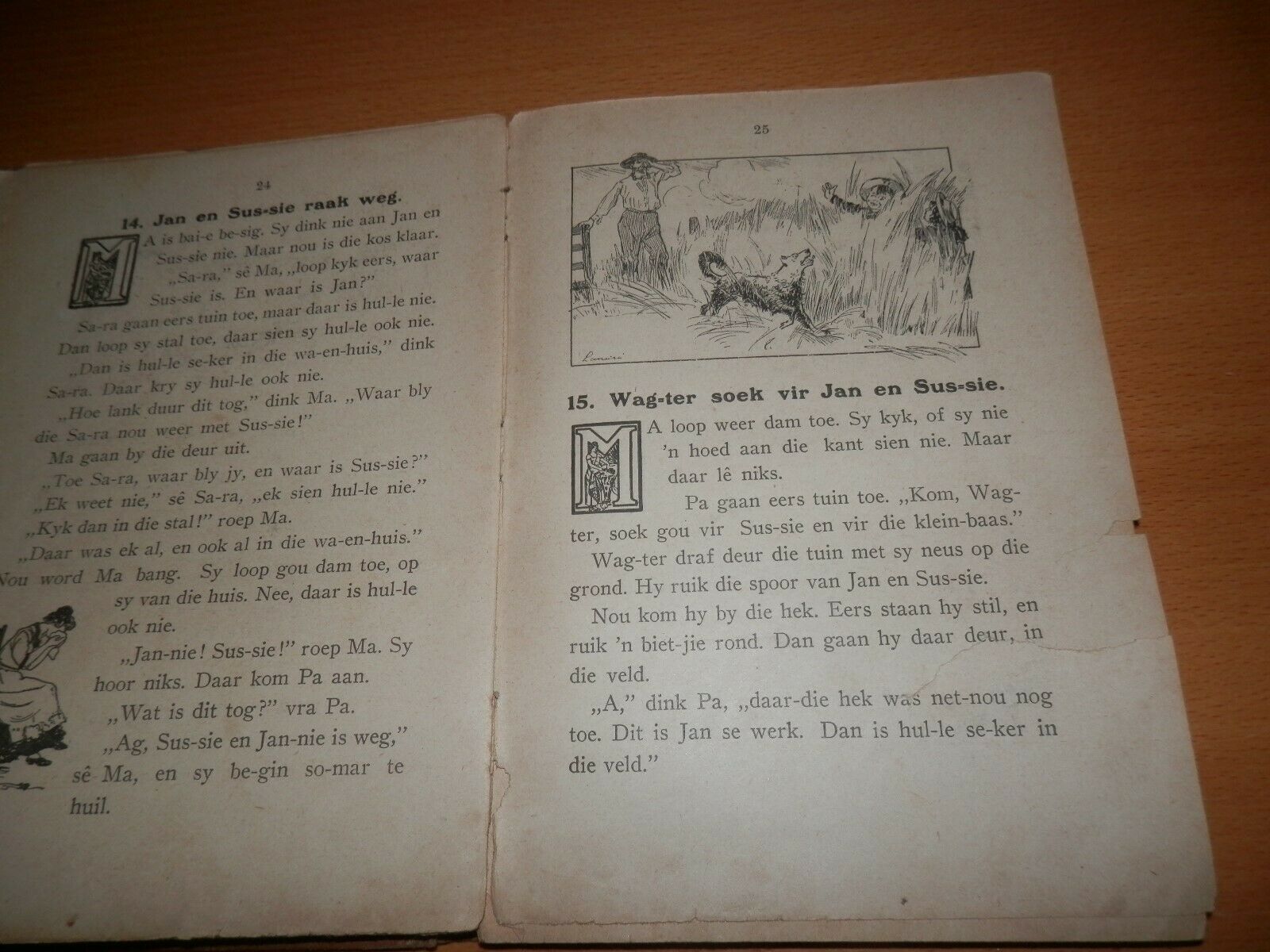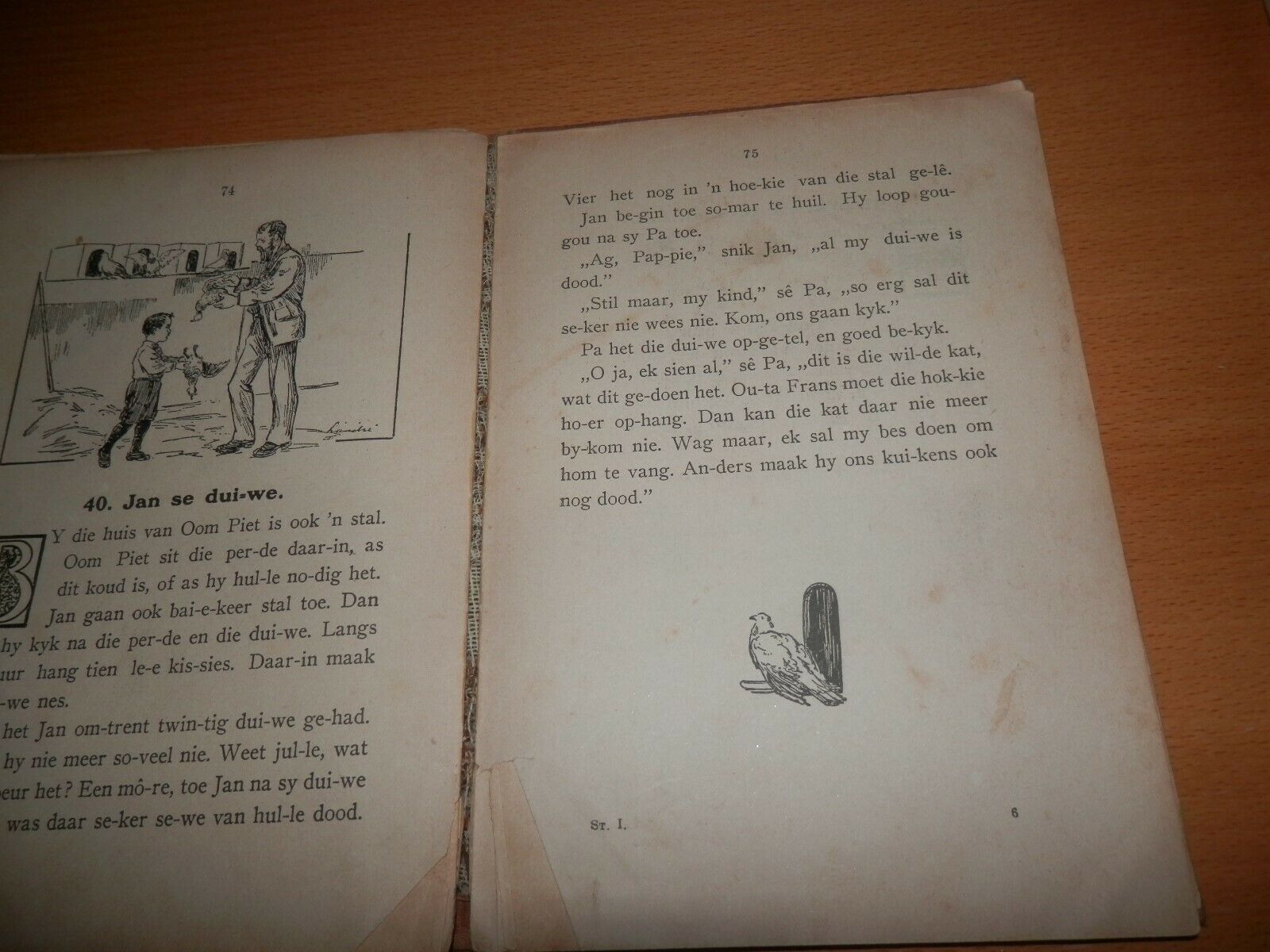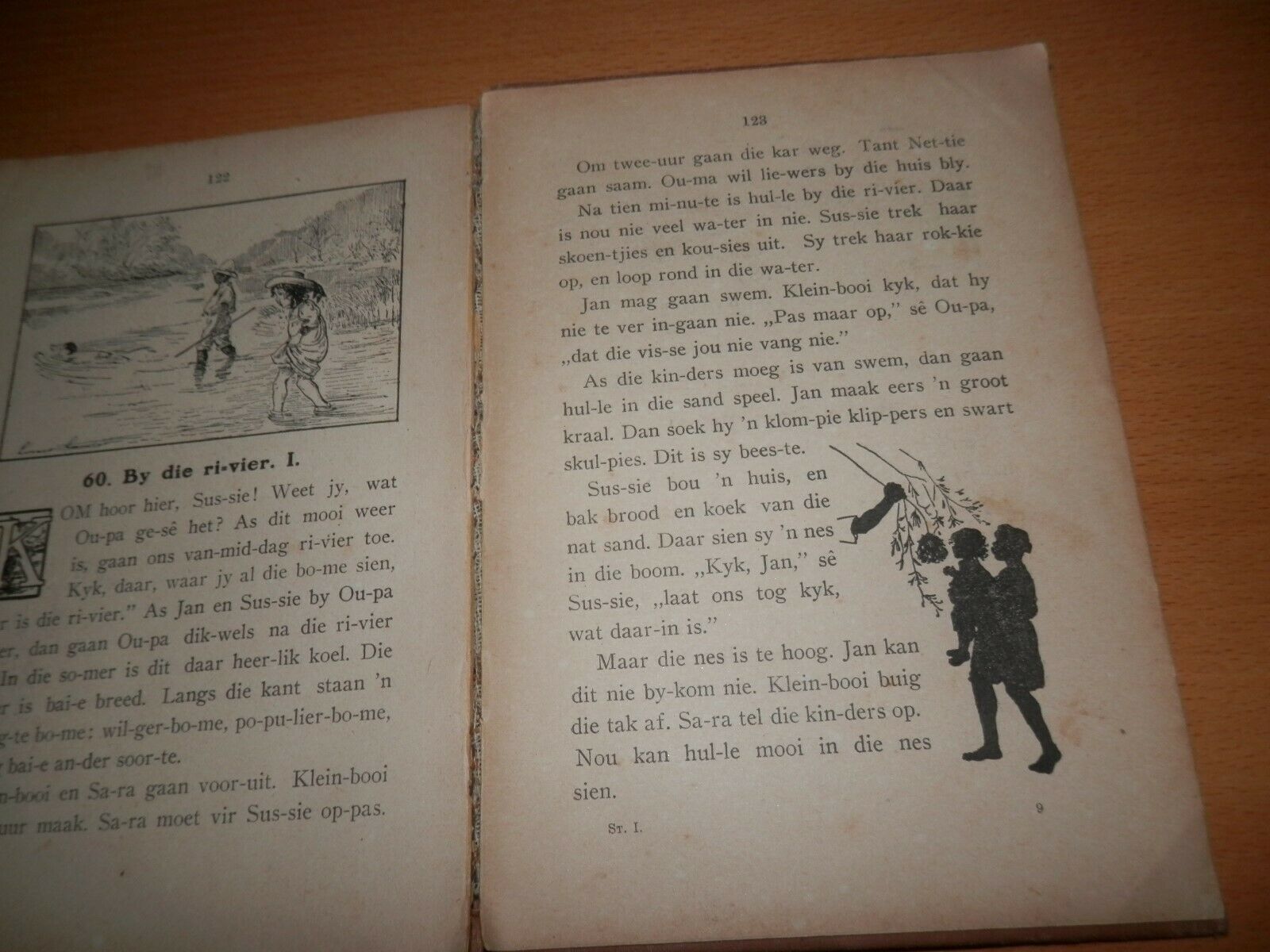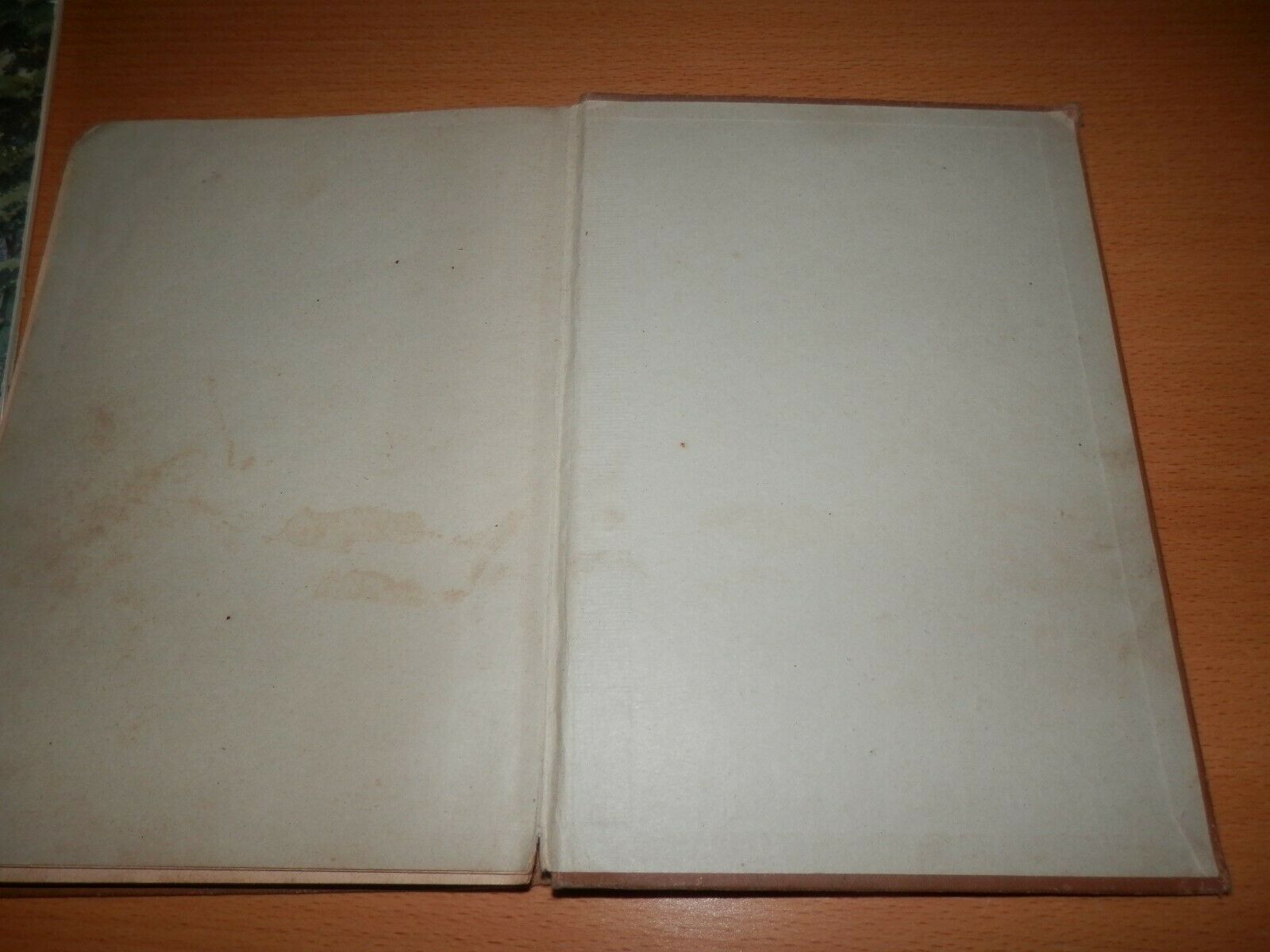De Bussy Se Leesboek Vir Suidafrika
Dublin Core
Date
Language
Format
Book Item Type Metadata
Listing Title
De Bussy Se Leesboek Vir Suidafrika Afrikaans South Africa Year 1 textbook 1924
Seller ID
Seller Notes
Afrikaans (UK: /ˌæfrɪˈkɑːns, -ˈkɑːnz/, US: /ˌɑːf-/)[5][6] is a West Germanic language spoken in South Africa, Namibia and, to a lesser extent, Botswana and Zimbabwe. It evolved from the Dutch vernacular[7][8] of South Holland (Hollandic dialect)[9][10] spoken by the mainly Dutch settlers of what is now South Africa, where it gradually began to develop distinguishing characteristics in the course of the 18th century.[11] Hence, it is a daughter language of Dutch, and was previously referred to as "Cape Dutch" (a term also used to refer collectively to the early Cape settlers) or "kitchen Dutch" (a derogatory term used to refer to Afrikaans in its earlier days). However, it is also variously described as a creole or as a partially creolised language.[n 1] The term is ultimately derived from Dutch Afrikaans-Hollands meaning "African Dutch".
Although Afrikaans has adopted words from other languages, including German and the Khoisan languages, an estimated 90 to 95% of the vocabulary of Afrikaans is of Dutch origin.[n 2] Therefore, differences with Dutch often lie in the more analytic-type morphology and grammar of Afrikaans, and a spelling that expresses Afrikaans pronunciation rather than standard Dutch.[n 3] There is a large degree of mutual intelligibility between the two languages—especially in written form.[n 4]
With about 7 million native speakers in South Africa, or 13.5% of the population, it is the third-most-spoken language in the country.[12] It has the widest geographical and racial distribution of all the 11 official languages of South Africa, and is widely spoken and understood as a second or third language.[n 5] It is the majority language of the western half of South Africa—the provinces of the Northern Cape and Western Cape—and the first language of 75.8% of Coloured South Africans (4.8 million people), 60.8% of White South Africans (2.7 million); 4.6% of Asian South Africans (58,000 people), and 1.5% of Black South Africans (600,000 people).[13]
In addition, many native speakers of Bantu languages and English also speak Afrikaans as a second language. It is taught in schools, with about 10.3 million second-language students.[1] One reason for the expansion of Afrikaans is its development in the public realm: it is used in newspapers, radio programs, TV, and several translations of the Bible have been published since the first one was completed in 1933.[1]
In neighbouring Namibia, Afrikaans is widely spoken as a second language and used as a lingua franca,[n 6] while as a native language it is spoken in 10.4% of households, mainly concentrated in the capital Windhoek, Walvis Bay, Swakopmund and the southern regions of Hardap and ǁKaras.[n 7] It, along with German, was among the official languages of Namibia until the country became independent in 1990, 25% of the population of Windhoek spoke Afrikaans at home.[1] Both Afrikaans and German are recognised regional languages in Namibia, although only English has official status within the government.
Estimates of the total number of Afrikaans speakers range between 15 and 23 million.[n 8]
Contents
1Etymology
2Mutual intelligibility with Dutch
3History
3.1Origin
3.2Development
3.3Recognition
3.3.1Monument
3.4Standardisation
3.5The Afrikaans Bible
4Classification
5Geographic distribution
5.1Statistics
5.2Sociolinguistics
6Current status
7Dialects
7.1Kaapse Afrikaans
7.2Oranjerivierafrikaans
7.3Expatriate geolect
8Influences on Afrikaans from other languages
8.1Malay
8.2Portuguese
8.3Khoisan languages
8.4Bantu languages
8.5French
9Grammar
10Phonology
10.1Vowels
10.2Consonants
11Orthography
11.1Initial apostrophes
11.2Table of characters
12Afrikaans phrases
13Sample text
14See also
15Notes
16References
17Bibliography
18Further reading
19External links
Etymology[edit]
The term is ultimately derived from the Dutch term Afrikaans-Hollands meaning "African Dutch".
Mutual intelligibility with Dutch[edit]
An estimated 90 to 95% of the Afrikaans lexicon is ultimately of Dutch origin,[14][15][16] and there are few lexical differences between the two languages.[17] Afrikaans has a considerably more regular morphology,[18] grammar, and spelling.[19] There is a degree of mutual intelligibility between the two languages,[18][20][21] particularly in written form.[19][22][23]
Afrikaans acquired some lexical and syntactical borrowings from other languages such as Malay, Khoisan languages, Portuguese,[24] and Bantu languages,[25] and Afrikaans has also been significantly influenced by South African English.[26] Dutch speakers are confronted with fewer non-cognates when listening to Afrikaans than the other way round.[23] Mutual intelligibility thus tends to be asymmetrical, as it is easier for Dutch speakers to understand Afrikaans than for Afrikaans speakers to understand Dutch.[23]
In general, mutual intelligibility between Dutch and Afrikaans is better than between Dutch and Frisian[27] or between Danish and Swedish.[23] The South African poet writer Breyten Breytenbach, attempting to visualize the language distance for anglophones once remarked that the differences between (Standard) Dutch and Afrikaans are comparable to those between the Received Pronunciation and Southern American English.[28]
History[edit]
Origin[edit]
The Afrikaans language arose in the Dutch Cape Colony, through a gradual divergence from European Dutch dialects, during the course of the 18th century.[29][30] As early as the mid-18th century and as recently as the mid-20th century, Afrikaans was known in standard Dutch as a "kitchen language" (Afrikaans: kombuistaal), lacking the prestige accorded, for example, even by the educational system in Africa, to languages spoken outside Africa. Other early epithets setting apart Kaaps Hollands ("Cape Dutch", i.e. Afrikaans) as putatively beneath official Dutch standards included geradbraakt, gebroken and onbeschaafd Hollands ("mutilated/broken/uncivilised Dutch"), as well as verkeerd Nederlands ("incorrect Dutch").[31][32]
'Hottentot Dutch'
Language family
Dutch-based pidgin
Language codes
ISO 639-3
None (mis)
Glottolog
hott1234[33]
Den Besten theorizes that modern Standard Afrikaans derives from two sources:[34]
Cape Dutch, a direct transplantation of European Dutch to southern Africa, and
'Hottentot Dutch',[33] a pidgin that descended from 'Foreigner Talk' and ultimately from the Dutch pidgin spoken by slaves, via a hypothetical Dutch creole.
Thus in his view Afrikaans is neither a creole nor a direct descendant of Dutch, but a fusion of two transmission pathways.
Development[edit]
A relative majority of the first settlers whose descendants today are the Afrikaners were from the United Provinces (now Netherlands and Flanders),[35] though up to one-sixth of the community was also of French Huguenot origin, and a seventh from Germany.[36]
African and Asian workers and slaves contributed to the development of Afrikaans. The slave population was made up of people from East Africa, West Africa, India, Madagascar, and the Dutch East Indies (modern Indonesia).[37] A number were also indigenous Khoisan people, who were valued as interpreters, domestic servants, and labourers. Many free and enslaved women married, cohabited with, or were victims of sexual violence from the male Dutch settlers. M. F. Valkhoff argued that 75% of children born to female slaves in the Dutch Cape Colony between 1652 and 1672 had a Dutch father.[38] Some consider this the origin of the ethnic group, the Cape Coloureds, who adopted various forms of speech utilising a Dutch vocabulary. Sarah Grey Thomason and Terrence Kaufman argue that Afrikaans' development as a separate language was "heavily conditioned by nonwhites who learned Dutch imperfectly as a second language."[39]
Beginning in about 1815, Afrikaans started to replace Malay as the language of instruction in Muslim schools in South Africa, written with the Arabic alphabet: see Arabic Afrikaans. Later, Afrikaans, now written with the Latin script, started to appear in newspapers and political and religious works in around 1850.[29]
In 1875, a group of Afrikaans-speakers from the Cape formed the Genootskap vir Regte Afrikaanders ("Society for Real Afrikaners"),[29] and published a number of books in Afrikaans including grammars, dictionaries, religious materials and histories. In 1925, Afrikaans was recognised by the South African government as a real language, rather than simply a slang version of Dutch proper.[29]
Recognition[edit]
Afrikaans was considered a Dutch dialect in South Africa until the early 20th century, when it became recognised as a distinct language under South African law, alongside Standard Dutch, which it eventually replaced as an official language.[40]
Before the Boer Wars (1880–81 and 1899–1902), "and indeed for some time afterwards, Afrikaans was regarded as inappropriate for educated discourse. Rather, Afrikaans was described derogatorily as ‘a kitchen language’ or as ‘a bastard jargon', suitable for communication mainly between the Boers and their servants."[41] 23 years after the Second Boer War ended in 1902, mostly due to the efforts of the Afrikans Language Movement[41] on 8 May 1925, the Official Languages of the Union Act No 8 of 1925 was passed at a joint sitting of the House of Assembly and the Senate,[42] in which 'Dutch' was "declared to include Afrikaans". The Constitution of 1961 reversed the position of Afrikaans and Dutch, so that English and Afrikaans were the official languages and Afrikaans was deemed to include Dutch. The Constitution of 1983 removed any mention of Dutch altogether.
Monument[edit]
A slogan in front of the Afrikaans Language Monument, near Paarl, South Africa. The Afrikaans Language Monument.
(Afrikaanse Taalmonument) is located on a hill overlooking Paarl, Western Cape Province, South Africa. Officially opened on 10 October 1975,[43] it commemorates the 50th anniversary of Afrikaans being declared an official language of South Africa in distinction to Dutch. It was erected in Paarl on the 100th anniversary of the founding of the Genootskap van Regte Afrikaners (Society of Real Afrikaners), an organisation which helped to strengthen Afrikaner identity and linguistic pride.[44]
Standardisation[edit]
The side view of the Pretoria Art Museum in Arcadia, Pretoria, with an Afrikaans language sign.
The linguist Paul Roberge suggested the earliest 'truly Afrikaans' texts are doggerel verse from 1795 and a dialogue transcribed by a Dutch traveller in 1825. Printed material among the Afrikaners at first used only standard European Dutch. By the mid-19th century, more and more were appearing in Afrikaans, which was very much still regarded as a set of regional dialects.
In 1861, L.H. Meurant published his Zamenspraak tusschen Klaas Waarzegger en Jan Twyfelaar ("Conversation between Claus Truthsayer and John Doubter"), which is considered by some to be the first authoritative Afrikaans text.[citation needed] Abu Bakr Effendi also compiled his Arabic Afrikaans Islamic instruction book between 1862 and 1869, although this was only published and printed in 1877. The first Afrikaans grammars and dictionaries were published in 1875 by the Genootskap vir Regte Afrikaners ("Society for Real Afrikaners") in Cape Town.[citation needed]
The main Afrikaans dictionary is the Woordeboek van die Afrikaanse Taal (WAT) (Dictionary of the Afrikaans Language), which is as yet incomplete owing to the scale of the project, but the one-volume dictionary in household use is the Verklarende Handwoordeboek van die Afrikaanse Taal (HAT). The official orthography of Afrikaans is the Afrikaanse Woordelys en Spelreëls, compiled by Die Taalkommissie.
The Afrikaans Bible[edit]
Main article: Bible translations into Afrikaans
The Afrikaner religion had stemmed from the Protestant practices of the Reformed church of Holland during the 17th century, later on being influenced in South Africa by British ministries during the 1800s.[45] A landmark in the development of the language was the translation of the whole Bible into Afrikaans. While significant advances had been made in the textual criticism of the Bible, especially the Greek New Testament, the 1933 translation followed the textus receptus and was closely akin to the Statenbijbel. Before this, most Cape Dutch-Afrikaans speakers had to rely on the Dutch Statenbijbel. This Statenvertaling had its origins with the Synod of Dordrecht of 1618 and was thus in an archaic form of Dutch. This was hard for Dutch and Cape Dutch speakers to understand, and increasingly unintelligible for Afrikaans speakers.
C. P. Hoogehout, Arnoldus Pannevis, and Stephanus Jacobus du Toit were the first Afrikaans Bible translators. Important landmarks in the translation of the Scriptures were in 1878 with C. P. Hoogehout's translation of the Evangelie volgens Markus (Gospel of Mark, lit. Gospel according to Mark); however, this translation was never published. The manuscript is to be found in the South African National Library, Cape Town.
The first official translation of the entire Bible into Afrikaans was in 1933 by J. D. du Toit, E. E. van Rooyen, J. D. Kestell, H. C. M. Fourie, and BB Keet.[46][47] This monumental work established Afrikaans as 'n suiwer en ordentlike taal, that is "a pure and proper language" for religious purposes, especially amongst the deeply Calvinist Afrikaans religious community that previously had been sceptical of a Bible translation that varied from the Dutch version that they were used to.
In 1983, a fresh translation marked the 50th anniversary of the 1933 version and provided a much-needed revision. The final editing of this edition was done by E. P. Groenewald, A. H. van Zyl, P. A. Verhoef, J. L. Helberg and W. Kempen. This translation was influenced by Eugene Nida's theory of dynamic-equavalence which focussed on finding the nearest equavalent in the receptor language to the idea that the Greek, Hebrew or Aramaic wanted to convey. The challenge to this type of translation is that it doesn't take into account that there are shifts in meaning in the receptor language.[citation needed]
A new translation, Die Bybel: 'n Direkte Vertaling is currently under preparation. It will be the first truly ecumenical translation of the Bible in Afrikaans as translators from various churches, including the Roman Catholic and Anglican Churches, are involved.[citation needed]
Various commercial translations of the Bible in Afrikaans have also appeared since the 1990s, such as Die Boodskap and the Nuwe Lewende Vertaling. Most of these translations were published by Christelike Uitgewersmaatskappy (CUM).[citation needed][vague]
Classification[edit]
The simplified relation between the West Germanic languages.
Indo-European languages
Germanic
West Germanic
Low Franconian
Dutch
Afrikaans, Dutch-based creoles
Afrikaans belongs to its own West Germanic sub-group, the Low Franconian languages. Its closest relative is the mutually-intelligible mother language, Dutch. Other West Germanic languages related to Afrikaans are German, English, the Frisian languages, and the unstandardised languages Low German and Yiddish.
Geographic distribution[edit]
Statistics[edit]
The geographical distribution of Afrikaans in South Africa: proportion of the population that speaks Afrikaans at home.
0–20%
20–40%
40–60%
60–80%
80–100%
Country
Speakers
Percentage
Year
Reference
Australia
43,741
0.26%
2016
[48]
Botswana
8,082
0.39%
2011
[48]
England and Wales
11,247
0.021%
2011
[49]
Mauritius
36
0.002%
2011
[48]
Namibia
219,760
10.4%
2011
[48]
New Zealand
21,123
0.52%
2006
[48]
South Africa
6,855,082
13.5%
2011
[48]
United States
28,406
0.01%
2016
[50]
Total
7,187,477
Sociolinguistics[edit]
Some state that instead of Afrikaners, which refers to an ethnic group, the terms Afrikaanses or Afrikaanssprekendes (lit. Afrikaans speakers) should be used for people of any ethnic origin who speak Afrikaans. Linguistic identity has not yet established which terms shall prevail, and all three are used in common parlance.[51] Afrikaans terms like boerseun (farm boy) and boeremeisie (farm girl) became popular among young white Afrikaners for expressing ethnic and cultural pride, regardless of whether or not they actually grew up on a farm.
The geographical distribution of Afrikaans in South Africa: density of Afrikaans home-language speakers.
<1 /km2
1–3 /km2
3–10 /km2
10–30 /km2
30–100 /km2
100–300 /km2
300–1000 /km2
1000–3000 /km2
>3000 /km2
The geographical distribution of Afrikaans in Namibia.
Afrikaans is also widely spoken in Namibia. Before independence, Afrikaans had equal status with German as an official language. Since independence in 1990, Afrikaans has had constitutional recognition as a national, but not official, language.[52][53] There is a much smaller number of Afrikaans speakers among Zimbabwe's white minority, as most have left the country since 1980. Afrikaans was also a medium of instruction for schools in Bophuthatswana, an Apartheid-era Bantustan.[54]
Many South Africans living and working in Belgium, the Netherlands, the United Kingdom, Republic of Ireland, Australia, New Zealand, Canada, the United States, the UAE and Kuwait are also Afrikaans-speaking. They have access to Afrikaans websites, news sites such as Netwerk24.com and Sake24, and radio broadcasts over the web, such as those from Radio Sonder Grense, Bokradio and Radio Pretoria.
Afrikaans has been influential in the development of South African English. Many Afrikaans loanwords have found their way into South African English, such as bakkie ("pickup truck"), braai ("barbecue"), naartjie ("tangerine"), tekkies (American "sneakers", British "trainers", Canadian "runners"). A few words in standard English are derived from Afrikaans, such as aardvark (lit. "earth pig"), trek ("pioneering journey", in Afrikaans lit. "pull" but used also for "migrate"), spoor ("animal track"), veld ("Southern African grassland" in Afrikaans, lit. "field"), commando from Afrikaans kommando meaning small fighting unit, boomslang ("tree snake") and apartheid ("segregation"; more accurately "apartness" or "the state or condition of being apart").
In 1976, secondary-school pupils in Soweto began a rebellion in response to the government's decision that Afrikaans be used as the language of instruction for half the subjects taught in non-White schools (with English continuing for the other half). Although English is the mother tongue of only 8.2% of the population, it is the language most widely understood, and the second language of a majority of South Africans.[55] Afrikaans is more widely spoken than English in the Northern and Western Cape provinces, several hundred kilometres from Soweto.[56]
The Black community's opposition to Afrikaans and preference for continuing English instruction was underlined when the government rescinded the policy one month after the uprising: 96% of Black schools chose English (over Afrikaans or native languages) as the language of instruction.[56] Also, due to Afrikaans being viewed as the language of the white oppressor by some, pressure has been increased to remove Afrikaans as a teaching language in South African universities, resulting in bloody student protests in 2015.[57][58][59]
Under South Africa's Constitution of 1996, Afrikaans remains an official language, and has equal status to English and nine other languages. The new policy means that the use of Afrikaans is now often reduced in favour of English, or to accommodate the other official languages. In 1996, for example, the South African Broadcasting Corporation reduced the amount of television airtime in Afrikaans, while South African Airways dropped its Afrikaans name Suid-Afrikaanse Lugdiens from its livery. Similarly, South Africa's diplomatic missions overseas now only display the name of the country in English and their host country's language, and not in Afrikaans.
In spite of these moves, the language has remained strong, and Afrikaans newspapers and magazines continue to have large circulation figures. Indeed, the Afrikaans-language general-interest family magazine Huisgenoot has the largest readership of any magazine in the country.[60] In addition, a pay-TV channel in Afrikaans called KykNet was launched in 1999, and an Afrikaans music channel, MK (Musiek kanaal) (lit. 'Music Channel'), in 2005. A large number of Afrikaans books are still published every year, mainly by the publishers Human & Rousseau, Tafelberg Uitgewers, Struik, and Protea Boekhuis. The Afrikaans film trilogy Bakgat (first released in 2008) caused a reawakening of the Afrikaans film Industry (which has been dead since the mid to late 1990s) and Belgian-born singer Karen Zoid's debut single "Afrikaners is Plesierig" (released 2001) caused a resurgence in the Afrikaans music industry as well as gave rise to the Afrikaans Rock genre.
Afrikaans has two monuments erected in its honour. The first was erected in Burgersdorp, South Africa, in 1893, and the second, nowadays better-known Afrikaans Language Monument (Afrikaanse Taalmonument), was built in Paarl, South Africa, in 1975.
When the British design magazine Wallpaper described Afrikaans as "one of the world's ugliest languages" in its September 2005 article about the monument,[61] South African billionaire Johann Rupert (chairman of the Richemont Group), responded by withdrawing advertising for brands such as Cartier, Van Cleef & Arpels, Montblanc and Alfred Dunhill from the magazine.[62] The author of the article, Bronwyn Davies, was an English-speaking South African.
Modern Dutch and Afrikaans share over 90 percent of their vocabulary. Afrikaans speakers are able to learn Dutch within a comparatively short time. Native Dutch speakers pick up written Afrikaans even more quickly, due to its simplified grammar,[citation needed] whereas understanding spoken Afrikaans might need more effort. Afrikaans speakers can learn Dutch pronunciation with little training. This has enabled Dutch and Belgian companies to outsource their call centre operations to South Africa.[63]
Current status[edit]
Use of Afrikaans as a first language by province
Province
1996[64]
2001[64]
2011[64]
Western Cape
58.5%
55.3%
49.7%
Eastern Cape
9.8%
9.6%
10.6%
Northern Cape
57.2%
56.6%
53.8%
Free State
14.4%
11.9%
12.7%
KwaZulu-Natal
1.6%
1.5%
1.6%
North West
8.8%
8.8%
9.0%
Gauteng
15.6%
13.6%
12.4%
Mpumalanga
7.1%
5.5%
7.2%
Limpopo
2.6%
2.6%
2.6%
South Africa
14.4%[65]
13.3%[66]
13.5%[12]
Post-apartheid South Africa has seen a loss of preferential treatment by the government for Afrikaans, in terms of education, social events, media (TV and radio), and general status throughout the country, given that it now shares its place as official language with ten other languages. Nevertheless, Afrikaans remains more prevalent in the media – radio, newspapers and television[67] – than any of the other official languages, except English. More than 300 book titles in Afrikaans are published annually.[68] South African census figures suggest a growing number of speakers in all nine provinces, a total of 6.85 million in 2011 compared to 5.98 million a decade earlier.[69] The South African Institute of Race Relations (SAIRR) project that a growing majority will be Coloured Afrikaans speakers.[70] Afrikaans speakers experience higher employment rates than other South African language groups, though half a million remain unemployed.[69]
Despite the challenges of demotion and emigration that it faces in South Africa, the Afrikaans vernacular remains competitive, being popular in DSTV pay channels and several internet sites, while generating high newspaper and music CD sales. A resurgence in Afrikaans popular music since the late 1990s has invigorated the language, especially among a younger generation of South Africans. A recent trend is the increased availability of pre-school educational CDs and DVDs. Such media also prove popular with the extensive Afrikaans-speaking expatriate communities who seek to retain language proficiency in a household context.
After years of slumber, Afrikaans language cinema is showing signs of new vigour. The 2007 film Ouma se slim kind, the first full-length Afrikaans movie since Paljas in 1998, is seen as the dawn of a new era in Afrikaans cinema. Several short films have been created and more feature-length movies, such as Poena is Koning and Bakgat (both in 2008) have been produced, besides the 2011 Afrikaans-language film Skoonheid, which was the first Afrikaans film to screen at the Cannes Film Festival. The film Platteland was also released in 2011.[71] The Afrikaans Film industry started gaining international recognition via the likes of big Afrikaans Hollywood film stars, like Charlize Theron (Monster) and Sharlto Copley (District 9) promoting their mother tongue.
Afrikaans seems to be returning to the SABC. SABC3 announced early in 2009 that it would increase Afrikaans programming due to the "growing Afrikaans-language market and [their] need for working capital as Afrikaans advertising is the only advertising that sells in the current South African television market". In April 2009, SABC3 started screening several Afrikaans-language programmes.[72] Further latent support for the language derives from its de-politicised image in the eyes of younger-generation South Africans, who less and less often view it as "the language of the oppressor".[citation needed] Indeed, there is a groundswell movement within Afrikaans to be inclusive, and to promote itself along with the other indigenous official languages. In Namibia, the percentage of Afrikaans speakers declined from 11.4% (2001 Census) to 10.4% (2011 Census). The major concentrations are in Hardap (41.0%), ǁKaras (36.1%), Erongo (20.5%), Khomas (18.5%), Omaheke (10.0%), Otjozondjupa (9.4%), Kunene (4.2%), and Oshikoto (2.3%).[73]
Afrikaans is offered at many universities outside of South Africa including in the Netherlands, Belgium, Germany, Poland, Russia and America.[74]
Dialects[edit]
A warning sign in Afrikaans: Gevaar Slagysters or "Danger, Bear Traps".
Following early dialectal studies of Afrikaans, it was theorised that three main historical dialects probably existed after the Great Trek in the 1830s. These dialects are the Northern Cape, Western Cape, and Eastern Cape dialects.[75] Northern Cape dialect may have resulted from contact between Dutch settlers and the Khoi-Khoi people between the Great Karoo and the Kunene, and Eastern Cape dialect between the Dutch and the Xhosa. Remnants of these dialects still remain in present-day Afrikaans, although the standardising effect of Standard Afrikaans has contributed to a great levelling of differences in modern times.[76][citation needed]
There is also a prison cant, known as soebela or sombela, which is based on Afrikaans, yet heavily influenced by Zulu. This language is used as a secret language in prison and is taught to initiates.[76]
Kaapse Afrikaans[edit]
The term Kaapse Afrikaans ("Cape Afrikaans") is sometimes erroneously used to refer to the entire Western Cape dialect; it is more commonly used for a particular sociolect spoken in the Cape Peninsula of South Africa. Kaapse Afrikaans was once spoken by all population groups. However, it became increasingly restricted to the Cape Coloured ethnic group in Cape Town and environs. Kaapse Afrikaans is still understood by the large majority of native Afrikaans speakers in South Africa.
Kaapse Afrikaans preserves some features more similar to Dutch than to Afrikaans.[77]
The 1st person singular pronoun ik as in Dutch as opposed to Afrikaans ek
The diminutive endings -tje, pronounced as in Dutch and not as /ki/ as in Afrikaans.
The use of the form seg (compare Dutch zegt) as opposed to Afrikaans sê
Kaapse Afrikaans has some other features not typically found in Afrikaans.
The pronunciation of j, normally /j/ as in Dutch is often a /dz/. This is the strongest feature of Kaapse Afrikaans.
The insertion of /j/ after /s/, /t/ and /k/ when followed by /e/, e.g. kjen as opposed to Standard Afrikaans ken.
Kaapse Afrikaans is also characterised by much code-switching between English and Afrikaans, especially in the inner-city and lower socio-economic status areas of Cape Town.
An example of characteristic Kaapse Afrikaans:
Dutch: En ik zeg (tegen) jullie: wat zoeken jullie hier bij mij? Ik zoek jullie niet! Nee, ga nu weg!
Kaapse Afrikaans: | En ik seg ve' djille, wat soek djille hie' by my? Ik soek'ie ve' djille nie! Nei, gaat nou weg!
Afrikaans: En ek sê vir julle, wat soek julle hier by my? Ek soek julle nie! Nee, gaan nou weg!
English (literal): | And I say to you, what seek you here by me? I seek you not! No, go now away!
English: And I'm telling you, what are you looking for here? I'm not looking for you! No, go away now!
Oranjerivierafrikaans[edit]
The term Oranjerivierafrikaans ("Afrikaans of the Orange River") is sometimes erroneously used to refer to the Northern Cape dialect; it is more commonly used for the regional peculiarities of standard Afrikaans spoken in the Upington/Orange River wine district of South Africa.
Some of the characteristics of Oranjerivierafrikaans are the plural form -goed (Ma-goed, meneergoed), variant pronunciation such as in kjerk ("Church") and gjeld ("money") and the ending -se, which indicates possession.
Expatriate geolect[edit]
Although Afrikaans is mainly spoken in South Africa and Namibia, smaller Afrikaans-speaking populations live in Argentina,[78] Australia, Botswana, Brazil, Canada, Lesotho, Malawi, the Netherlands, New Zealand, Eswatini, the UAE, the United Kingdom, Republic of Ireland, the US, Zambia, and Zimbabwe.[1] Most Afrikaans-speaking people living outside Africa are emigrants and their descendants. Because of emigration and migrant labour, more than 100,000 Afrikaans speakers may live in the United Kingdom.
Influences on Afrikaans from other languages[edit]
Malay[edit]
Due to the early settlement of a Cape Malay community in Cape Town, who are now known as Coloureds, numerous Classical Malay words were brought into Afrikaans. Some of these words entered Dutch via people arriving from, what is now known as, Indonesia as part of their colonial heritage. Malay words in Afrikaans include:[79]
baie, which means 'very'/'much'/'many' (from banyak) is a very commonly used Afrikaans word, different from its Dutch equivalent veel or erg.
baadjie, Afrikaans for jacket, where Dutch would use jas or vest. The word baadje in Dutch is now considered archaic and only used in written, literary texts.
piesang, which means banana. This is different from the common Dutch word banaan. The Indonesian word pisang is also used in Dutch, though usage is less common.
Portuguese[edit]
Some words originally came from Portuguese such as sambreel ("umbrella") from the Portuguese sombreiro, kraal ("pen/cattle enclosure") from the Portuguese curral, and mielie ("corn", from milho). These words have become common in South Africa to an extent of being used in many other South African languages. Some of these words also exist in Dutch, like sambreel "parasol",[80] though usage is less common and meanings can slightly differ.
Khoisan languages[edit]
dagga, meaning cannabis[79]
geitjie, meaning lizard, diminutive adapted from Khoekhoe word[81]
gogga, meaning insect, from the Khoisan xo-xo
karos, blanket of animal hides
kierie walking stick from Khoekhoe[81]
Some of these words also exist in Dutch, though with a more specific meaning: assegaai for example means "South-African tribal javelin"[citation needed] and karos means "South-African tribal blanket of animal hides".[82]
Bantu languages[edit]
Loanwords from Bantu languages in Afrikaans include the names of indigenous birds, such as mahem and sakaboela, and indigenous plants, such as maroela and tamboekie(gras).[83]
fundi, from the Zulu word umfundi meaning "scholar" or "student",[84] but used to mean someone who is a student/expert on a certain subject, i.e. He is a language fundi.
lobola, meaning bride price, from (and referring to) lobolo of the Nguni languages[85]
mahem, the grey crowned crane, known in Latin as Balearica regulorum
maroela, medium-sized dioecious tree known in Latin as Sclerocarya birrea[86]
tamboekiegras, species of thatching grass known as Hyparrhenia[87]
tambotie, deciduous tree also known by its Latin name, Spirostachys africana[88]
tjaila / tjailatyd, an adaption of the word chaile, meaning "to go home" or "to knock off".[89]
French[edit]
The revoking of the Edict of Nantes on the 22nd of October 1685 was a milestone in the history of South Africa, for it marked the beginning of the great Huguenot exodus from France. It is estimated that between 250,000 and 300,000 Protestants left France between 1685 and 1700; out of these, according to Louvois, 100,000 had received military training. A measure of the calibre of these immigrants and of their acceptance by host countries (in particular South Africa) is given by H.V. Morton in his book: In search of South Africa (London, 1948). The Huguenots were responsible for a great linguistic contribution to Afrikaans, particularly in terms of military terminology as many of them fought on the battlefields during the wars of the Great Trek.
Although Afrikaans has adopted words from other languages, including German and the Khoisan languages, an estimated 90 to 95% of the vocabulary of Afrikaans is of Dutch origin.[n 2] Therefore, differences with Dutch often lie in the more analytic-type morphology and grammar of Afrikaans, and a spelling that expresses Afrikaans pronunciation rather than standard Dutch.[n 3] There is a large degree of mutual intelligibility between the two languages—especially in written form.[n 4]
With about 7 million native speakers in South Africa, or 13.5% of the population, it is the third-most-spoken language in the country.[12] It has the widest geographical and racial distribution of all the 11 official languages of South Africa, and is widely spoken and understood as a second or third language.[n 5] It is the majority language of the western half of South Africa—the provinces of the Northern Cape and Western Cape—and the first language of 75.8% of Coloured South Africans (4.8 million people), 60.8% of White South Africans (2.7 million); 4.6% of Asian South Africans (58,000 people), and 1.5% of Black South Africans (600,000 people).[13]
In addition, many native speakers of Bantu languages and English also speak Afrikaans as a second language. It is taught in schools, with about 10.3 million second-language students.[1] One reason for the expansion of Afrikaans is its development in the public realm: it is used in newspapers, radio programs, TV, and several translations of the Bible have been published since the first one was completed in 1933.[1]
In neighbouring Namibia, Afrikaans is widely spoken as a second language and used as a lingua franca,[n 6] while as a native language it is spoken in 10.4% of households, mainly concentrated in the capital Windhoek, Walvis Bay, Swakopmund and the southern regions of Hardap and ǁKaras.[n 7] It, along with German, was among the official languages of Namibia until the country became independent in 1990, 25% of the population of Windhoek spoke Afrikaans at home.[1] Both Afrikaans and German are recognised regional languages in Namibia, although only English has official status within the government.
Estimates of the total number of Afrikaans speakers range between 15 and 23 million.[n 8]
Contents
1Etymology
2Mutual intelligibility with Dutch
3History
3.1Origin
3.2Development
3.3Recognition
3.3.1Monument
3.4Standardisation
3.5The Afrikaans Bible
4Classification
5Geographic distribution
5.1Statistics
5.2Sociolinguistics
6Current status
7Dialects
7.1Kaapse Afrikaans
7.2Oranjerivierafrikaans
7.3Expatriate geolect
8Influences on Afrikaans from other languages
8.1Malay
8.2Portuguese
8.3Khoisan languages
8.4Bantu languages
8.5French
9Grammar
10Phonology
10.1Vowels
10.2Consonants
11Orthography
11.1Initial apostrophes
11.2Table of characters
12Afrikaans phrases
13Sample text
14See also
15Notes
16References
17Bibliography
18Further reading
19External links
Etymology[edit]
The term is ultimately derived from the Dutch term Afrikaans-Hollands meaning "African Dutch".
Mutual intelligibility with Dutch[edit]
An estimated 90 to 95% of the Afrikaans lexicon is ultimately of Dutch origin,[14][15][16] and there are few lexical differences between the two languages.[17] Afrikaans has a considerably more regular morphology,[18] grammar, and spelling.[19] There is a degree of mutual intelligibility between the two languages,[18][20][21] particularly in written form.[19][22][23]
Afrikaans acquired some lexical and syntactical borrowings from other languages such as Malay, Khoisan languages, Portuguese,[24] and Bantu languages,[25] and Afrikaans has also been significantly influenced by South African English.[26] Dutch speakers are confronted with fewer non-cognates when listening to Afrikaans than the other way round.[23] Mutual intelligibility thus tends to be asymmetrical, as it is easier for Dutch speakers to understand Afrikaans than for Afrikaans speakers to understand Dutch.[23]
In general, mutual intelligibility between Dutch and Afrikaans is better than between Dutch and Frisian[27] or between Danish and Swedish.[23] The South African poet writer Breyten Breytenbach, attempting to visualize the language distance for anglophones once remarked that the differences between (Standard) Dutch and Afrikaans are comparable to those between the Received Pronunciation and Southern American English.[28]
History[edit]
Origin[edit]
The Afrikaans language arose in the Dutch Cape Colony, through a gradual divergence from European Dutch dialects, during the course of the 18th century.[29][30] As early as the mid-18th century and as recently as the mid-20th century, Afrikaans was known in standard Dutch as a "kitchen language" (Afrikaans: kombuistaal), lacking the prestige accorded, for example, even by the educational system in Africa, to languages spoken outside Africa. Other early epithets setting apart Kaaps Hollands ("Cape Dutch", i.e. Afrikaans) as putatively beneath official Dutch standards included geradbraakt, gebroken and onbeschaafd Hollands ("mutilated/broken/uncivilised Dutch"), as well as verkeerd Nederlands ("incorrect Dutch").[31][32]
'Hottentot Dutch'
Language family
Dutch-based pidgin
Language codes
ISO 639-3
None (mis)
Glottolog
hott1234[33]
Den Besten theorizes that modern Standard Afrikaans derives from two sources:[34]
Cape Dutch, a direct transplantation of European Dutch to southern Africa, and
'Hottentot Dutch',[33] a pidgin that descended from 'Foreigner Talk' and ultimately from the Dutch pidgin spoken by slaves, via a hypothetical Dutch creole.
Thus in his view Afrikaans is neither a creole nor a direct descendant of Dutch, but a fusion of two transmission pathways.
Development[edit]
A relative majority of the first settlers whose descendants today are the Afrikaners were from the United Provinces (now Netherlands and Flanders),[35] though up to one-sixth of the community was also of French Huguenot origin, and a seventh from Germany.[36]
African and Asian workers and slaves contributed to the development of Afrikaans. The slave population was made up of people from East Africa, West Africa, India, Madagascar, and the Dutch East Indies (modern Indonesia).[37] A number were also indigenous Khoisan people, who were valued as interpreters, domestic servants, and labourers. Many free and enslaved women married, cohabited with, or were victims of sexual violence from the male Dutch settlers. M. F. Valkhoff argued that 75% of children born to female slaves in the Dutch Cape Colony between 1652 and 1672 had a Dutch father.[38] Some consider this the origin of the ethnic group, the Cape Coloureds, who adopted various forms of speech utilising a Dutch vocabulary. Sarah Grey Thomason and Terrence Kaufman argue that Afrikaans' development as a separate language was "heavily conditioned by nonwhites who learned Dutch imperfectly as a second language."[39]
Beginning in about 1815, Afrikaans started to replace Malay as the language of instruction in Muslim schools in South Africa, written with the Arabic alphabet: see Arabic Afrikaans. Later, Afrikaans, now written with the Latin script, started to appear in newspapers and political and religious works in around 1850.[29]
In 1875, a group of Afrikaans-speakers from the Cape formed the Genootskap vir Regte Afrikaanders ("Society for Real Afrikaners"),[29] and published a number of books in Afrikaans including grammars, dictionaries, religious materials and histories. In 1925, Afrikaans was recognised by the South African government as a real language, rather than simply a slang version of Dutch proper.[29]
Recognition[edit]
Afrikaans was considered a Dutch dialect in South Africa until the early 20th century, when it became recognised as a distinct language under South African law, alongside Standard Dutch, which it eventually replaced as an official language.[40]
Before the Boer Wars (1880–81 and 1899–1902), "and indeed for some time afterwards, Afrikaans was regarded as inappropriate for educated discourse. Rather, Afrikaans was described derogatorily as ‘a kitchen language’ or as ‘a bastard jargon', suitable for communication mainly between the Boers and their servants."[41] 23 years after the Second Boer War ended in 1902, mostly due to the efforts of the Afrikans Language Movement[41] on 8 May 1925, the Official Languages of the Union Act No 8 of 1925 was passed at a joint sitting of the House of Assembly and the Senate,[42] in which 'Dutch' was "declared to include Afrikaans". The Constitution of 1961 reversed the position of Afrikaans and Dutch, so that English and Afrikaans were the official languages and Afrikaans was deemed to include Dutch. The Constitution of 1983 removed any mention of Dutch altogether.
Monument[edit]
A slogan in front of the Afrikaans Language Monument, near Paarl, South Africa. The Afrikaans Language Monument.
(Afrikaanse Taalmonument) is located on a hill overlooking Paarl, Western Cape Province, South Africa. Officially opened on 10 October 1975,[43] it commemorates the 50th anniversary of Afrikaans being declared an official language of South Africa in distinction to Dutch. It was erected in Paarl on the 100th anniversary of the founding of the Genootskap van Regte Afrikaners (Society of Real Afrikaners), an organisation which helped to strengthen Afrikaner identity and linguistic pride.[44]
Standardisation[edit]
The side view of the Pretoria Art Museum in Arcadia, Pretoria, with an Afrikaans language sign.
The linguist Paul Roberge suggested the earliest 'truly Afrikaans' texts are doggerel verse from 1795 and a dialogue transcribed by a Dutch traveller in 1825. Printed material among the Afrikaners at first used only standard European Dutch. By the mid-19th century, more and more were appearing in Afrikaans, which was very much still regarded as a set of regional dialects.
In 1861, L.H. Meurant published his Zamenspraak tusschen Klaas Waarzegger en Jan Twyfelaar ("Conversation between Claus Truthsayer and John Doubter"), which is considered by some to be the first authoritative Afrikaans text.[citation needed] Abu Bakr Effendi also compiled his Arabic Afrikaans Islamic instruction book between 1862 and 1869, although this was only published and printed in 1877. The first Afrikaans grammars and dictionaries were published in 1875 by the Genootskap vir Regte Afrikaners ("Society for Real Afrikaners") in Cape Town.[citation needed]
The main Afrikaans dictionary is the Woordeboek van die Afrikaanse Taal (WAT) (Dictionary of the Afrikaans Language), which is as yet incomplete owing to the scale of the project, but the one-volume dictionary in household use is the Verklarende Handwoordeboek van die Afrikaanse Taal (HAT). The official orthography of Afrikaans is the Afrikaanse Woordelys en Spelreëls, compiled by Die Taalkommissie.
The Afrikaans Bible[edit]
Main article: Bible translations into Afrikaans
The Afrikaner religion had stemmed from the Protestant practices of the Reformed church of Holland during the 17th century, later on being influenced in South Africa by British ministries during the 1800s.[45] A landmark in the development of the language was the translation of the whole Bible into Afrikaans. While significant advances had been made in the textual criticism of the Bible, especially the Greek New Testament, the 1933 translation followed the textus receptus and was closely akin to the Statenbijbel. Before this, most Cape Dutch-Afrikaans speakers had to rely on the Dutch Statenbijbel. This Statenvertaling had its origins with the Synod of Dordrecht of 1618 and was thus in an archaic form of Dutch. This was hard for Dutch and Cape Dutch speakers to understand, and increasingly unintelligible for Afrikaans speakers.
C. P. Hoogehout, Arnoldus Pannevis, and Stephanus Jacobus du Toit were the first Afrikaans Bible translators. Important landmarks in the translation of the Scriptures were in 1878 with C. P. Hoogehout's translation of the Evangelie volgens Markus (Gospel of Mark, lit. Gospel according to Mark); however, this translation was never published. The manuscript is to be found in the South African National Library, Cape Town.
The first official translation of the entire Bible into Afrikaans was in 1933 by J. D. du Toit, E. E. van Rooyen, J. D. Kestell, H. C. M. Fourie, and BB Keet.[46][47] This monumental work established Afrikaans as 'n suiwer en ordentlike taal, that is "a pure and proper language" for religious purposes, especially amongst the deeply Calvinist Afrikaans religious community that previously had been sceptical of a Bible translation that varied from the Dutch version that they were used to.
In 1983, a fresh translation marked the 50th anniversary of the 1933 version and provided a much-needed revision. The final editing of this edition was done by E. P. Groenewald, A. H. van Zyl, P. A. Verhoef, J. L. Helberg and W. Kempen. This translation was influenced by Eugene Nida's theory of dynamic-equavalence which focussed on finding the nearest equavalent in the receptor language to the idea that the Greek, Hebrew or Aramaic wanted to convey. The challenge to this type of translation is that it doesn't take into account that there are shifts in meaning in the receptor language.[citation needed]
A new translation, Die Bybel: 'n Direkte Vertaling is currently under preparation. It will be the first truly ecumenical translation of the Bible in Afrikaans as translators from various churches, including the Roman Catholic and Anglican Churches, are involved.[citation needed]
Various commercial translations of the Bible in Afrikaans have also appeared since the 1990s, such as Die Boodskap and the Nuwe Lewende Vertaling. Most of these translations were published by Christelike Uitgewersmaatskappy (CUM).[citation needed][vague]
Classification[edit]
The simplified relation between the West Germanic languages.
Indo-European languages
Germanic
West Germanic
Low Franconian
Dutch
Afrikaans, Dutch-based creoles
Afrikaans belongs to its own West Germanic sub-group, the Low Franconian languages. Its closest relative is the mutually-intelligible mother language, Dutch. Other West Germanic languages related to Afrikaans are German, English, the Frisian languages, and the unstandardised languages Low German and Yiddish.
Geographic distribution[edit]
Statistics[edit]
The geographical distribution of Afrikaans in South Africa: proportion of the population that speaks Afrikaans at home.
0–20%
20–40%
40–60%
60–80%
80–100%
Country
Speakers
Percentage
Year
Reference
Australia
43,741
0.26%
2016
[48]
Botswana
8,082
0.39%
2011
[48]
England and Wales
11,247
0.021%
2011
[49]
Mauritius
36
0.002%
2011
[48]
Namibia
219,760
10.4%
2011
[48]
New Zealand
21,123
0.52%
2006
[48]
South Africa
6,855,082
13.5%
2011
[48]
United States
28,406
0.01%
2016
[50]
Total
7,187,477
Sociolinguistics[edit]
Some state that instead of Afrikaners, which refers to an ethnic group, the terms Afrikaanses or Afrikaanssprekendes (lit. Afrikaans speakers) should be used for people of any ethnic origin who speak Afrikaans. Linguistic identity has not yet established which terms shall prevail, and all three are used in common parlance.[51] Afrikaans terms like boerseun (farm boy) and boeremeisie (farm girl) became popular among young white Afrikaners for expressing ethnic and cultural pride, regardless of whether or not they actually grew up on a farm.
The geographical distribution of Afrikaans in South Africa: density of Afrikaans home-language speakers.
<1 /km2
1–3 /km2
3–10 /km2
10–30 /km2
30–100 /km2
100–300 /km2
300–1000 /km2
1000–3000 /km2
>3000 /km2
The geographical distribution of Afrikaans in Namibia.
Afrikaans is also widely spoken in Namibia. Before independence, Afrikaans had equal status with German as an official language. Since independence in 1990, Afrikaans has had constitutional recognition as a national, but not official, language.[52][53] There is a much smaller number of Afrikaans speakers among Zimbabwe's white minority, as most have left the country since 1980. Afrikaans was also a medium of instruction for schools in Bophuthatswana, an Apartheid-era Bantustan.[54]
Many South Africans living and working in Belgium, the Netherlands, the United Kingdom, Republic of Ireland, Australia, New Zealand, Canada, the United States, the UAE and Kuwait are also Afrikaans-speaking. They have access to Afrikaans websites, news sites such as Netwerk24.com and Sake24, and radio broadcasts over the web, such as those from Radio Sonder Grense, Bokradio and Radio Pretoria.
Afrikaans has been influential in the development of South African English. Many Afrikaans loanwords have found their way into South African English, such as bakkie ("pickup truck"), braai ("barbecue"), naartjie ("tangerine"), tekkies (American "sneakers", British "trainers", Canadian "runners"). A few words in standard English are derived from Afrikaans, such as aardvark (lit. "earth pig"), trek ("pioneering journey", in Afrikaans lit. "pull" but used also for "migrate"), spoor ("animal track"), veld ("Southern African grassland" in Afrikaans, lit. "field"), commando from Afrikaans kommando meaning small fighting unit, boomslang ("tree snake") and apartheid ("segregation"; more accurately "apartness" or "the state or condition of being apart").
In 1976, secondary-school pupils in Soweto began a rebellion in response to the government's decision that Afrikaans be used as the language of instruction for half the subjects taught in non-White schools (with English continuing for the other half). Although English is the mother tongue of only 8.2% of the population, it is the language most widely understood, and the second language of a majority of South Africans.[55] Afrikaans is more widely spoken than English in the Northern and Western Cape provinces, several hundred kilometres from Soweto.[56]
The Black community's opposition to Afrikaans and preference for continuing English instruction was underlined when the government rescinded the policy one month after the uprising: 96% of Black schools chose English (over Afrikaans or native languages) as the language of instruction.[56] Also, due to Afrikaans being viewed as the language of the white oppressor by some, pressure has been increased to remove Afrikaans as a teaching language in South African universities, resulting in bloody student protests in 2015.[57][58][59]
Under South Africa's Constitution of 1996, Afrikaans remains an official language, and has equal status to English and nine other languages. The new policy means that the use of Afrikaans is now often reduced in favour of English, or to accommodate the other official languages. In 1996, for example, the South African Broadcasting Corporation reduced the amount of television airtime in Afrikaans, while South African Airways dropped its Afrikaans name Suid-Afrikaanse Lugdiens from its livery. Similarly, South Africa's diplomatic missions overseas now only display the name of the country in English and their host country's language, and not in Afrikaans.
In spite of these moves, the language has remained strong, and Afrikaans newspapers and magazines continue to have large circulation figures. Indeed, the Afrikaans-language general-interest family magazine Huisgenoot has the largest readership of any magazine in the country.[60] In addition, a pay-TV channel in Afrikaans called KykNet was launched in 1999, and an Afrikaans music channel, MK (Musiek kanaal) (lit. 'Music Channel'), in 2005. A large number of Afrikaans books are still published every year, mainly by the publishers Human & Rousseau, Tafelberg Uitgewers, Struik, and Protea Boekhuis. The Afrikaans film trilogy Bakgat (first released in 2008) caused a reawakening of the Afrikaans film Industry (which has been dead since the mid to late 1990s) and Belgian-born singer Karen Zoid's debut single "Afrikaners is Plesierig" (released 2001) caused a resurgence in the Afrikaans music industry as well as gave rise to the Afrikaans Rock genre.
Afrikaans has two monuments erected in its honour. The first was erected in Burgersdorp, South Africa, in 1893, and the second, nowadays better-known Afrikaans Language Monument (Afrikaanse Taalmonument), was built in Paarl, South Africa, in 1975.
When the British design magazine Wallpaper described Afrikaans as "one of the world's ugliest languages" in its September 2005 article about the monument,[61] South African billionaire Johann Rupert (chairman of the Richemont Group), responded by withdrawing advertising for brands such as Cartier, Van Cleef & Arpels, Montblanc and Alfred Dunhill from the magazine.[62] The author of the article, Bronwyn Davies, was an English-speaking South African.
Modern Dutch and Afrikaans share over 90 percent of their vocabulary. Afrikaans speakers are able to learn Dutch within a comparatively short time. Native Dutch speakers pick up written Afrikaans even more quickly, due to its simplified grammar,[citation needed] whereas understanding spoken Afrikaans might need more effort. Afrikaans speakers can learn Dutch pronunciation with little training. This has enabled Dutch and Belgian companies to outsource their call centre operations to South Africa.[63]
Current status[edit]
Use of Afrikaans as a first language by province
Province
1996[64]
2001[64]
2011[64]
Western Cape
58.5%
55.3%
49.7%
Eastern Cape
9.8%
9.6%
10.6%
Northern Cape
57.2%
56.6%
53.8%
Free State
14.4%
11.9%
12.7%
KwaZulu-Natal
1.6%
1.5%
1.6%
North West
8.8%
8.8%
9.0%
Gauteng
15.6%
13.6%
12.4%
Mpumalanga
7.1%
5.5%
7.2%
Limpopo
2.6%
2.6%
2.6%
South Africa
14.4%[65]
13.3%[66]
13.5%[12]
Post-apartheid South Africa has seen a loss of preferential treatment by the government for Afrikaans, in terms of education, social events, media (TV and radio), and general status throughout the country, given that it now shares its place as official language with ten other languages. Nevertheless, Afrikaans remains more prevalent in the media – radio, newspapers and television[67] – than any of the other official languages, except English. More than 300 book titles in Afrikaans are published annually.[68] South African census figures suggest a growing number of speakers in all nine provinces, a total of 6.85 million in 2011 compared to 5.98 million a decade earlier.[69] The South African Institute of Race Relations (SAIRR) project that a growing majority will be Coloured Afrikaans speakers.[70] Afrikaans speakers experience higher employment rates than other South African language groups, though half a million remain unemployed.[69]
Despite the challenges of demotion and emigration that it faces in South Africa, the Afrikaans vernacular remains competitive, being popular in DSTV pay channels and several internet sites, while generating high newspaper and music CD sales. A resurgence in Afrikaans popular music since the late 1990s has invigorated the language, especially among a younger generation of South Africans. A recent trend is the increased availability of pre-school educational CDs and DVDs. Such media also prove popular with the extensive Afrikaans-speaking expatriate communities who seek to retain language proficiency in a household context.
After years of slumber, Afrikaans language cinema is showing signs of new vigour. The 2007 film Ouma se slim kind, the first full-length Afrikaans movie since Paljas in 1998, is seen as the dawn of a new era in Afrikaans cinema. Several short films have been created and more feature-length movies, such as Poena is Koning and Bakgat (both in 2008) have been produced, besides the 2011 Afrikaans-language film Skoonheid, which was the first Afrikaans film to screen at the Cannes Film Festival. The film Platteland was also released in 2011.[71] The Afrikaans Film industry started gaining international recognition via the likes of big Afrikaans Hollywood film stars, like Charlize Theron (Monster) and Sharlto Copley (District 9) promoting their mother tongue.
Afrikaans seems to be returning to the SABC. SABC3 announced early in 2009 that it would increase Afrikaans programming due to the "growing Afrikaans-language market and [their] need for working capital as Afrikaans advertising is the only advertising that sells in the current South African television market". In April 2009, SABC3 started screening several Afrikaans-language programmes.[72] Further latent support for the language derives from its de-politicised image in the eyes of younger-generation South Africans, who less and less often view it as "the language of the oppressor".[citation needed] Indeed, there is a groundswell movement within Afrikaans to be inclusive, and to promote itself along with the other indigenous official languages. In Namibia, the percentage of Afrikaans speakers declined from 11.4% (2001 Census) to 10.4% (2011 Census). The major concentrations are in Hardap (41.0%), ǁKaras (36.1%), Erongo (20.5%), Khomas (18.5%), Omaheke (10.0%), Otjozondjupa (9.4%), Kunene (4.2%), and Oshikoto (2.3%).[73]
Afrikaans is offered at many universities outside of South Africa including in the Netherlands, Belgium, Germany, Poland, Russia and America.[74]
Dialects[edit]
A warning sign in Afrikaans: Gevaar Slagysters or "Danger, Bear Traps".
Following early dialectal studies of Afrikaans, it was theorised that three main historical dialects probably existed after the Great Trek in the 1830s. These dialects are the Northern Cape, Western Cape, and Eastern Cape dialects.[75] Northern Cape dialect may have resulted from contact between Dutch settlers and the Khoi-Khoi people between the Great Karoo and the Kunene, and Eastern Cape dialect between the Dutch and the Xhosa. Remnants of these dialects still remain in present-day Afrikaans, although the standardising effect of Standard Afrikaans has contributed to a great levelling of differences in modern times.[76][citation needed]
There is also a prison cant, known as soebela or sombela, which is based on Afrikaans, yet heavily influenced by Zulu. This language is used as a secret language in prison and is taught to initiates.[76]
Kaapse Afrikaans[edit]
The term Kaapse Afrikaans ("Cape Afrikaans") is sometimes erroneously used to refer to the entire Western Cape dialect; it is more commonly used for a particular sociolect spoken in the Cape Peninsula of South Africa. Kaapse Afrikaans was once spoken by all population groups. However, it became increasingly restricted to the Cape Coloured ethnic group in Cape Town and environs. Kaapse Afrikaans is still understood by the large majority of native Afrikaans speakers in South Africa.
Kaapse Afrikaans preserves some features more similar to Dutch than to Afrikaans.[77]
The 1st person singular pronoun ik as in Dutch as opposed to Afrikaans ek
The diminutive endings -tje, pronounced as in Dutch and not as /ki/ as in Afrikaans.
The use of the form seg (compare Dutch zegt) as opposed to Afrikaans sê
Kaapse Afrikaans has some other features not typically found in Afrikaans.
The pronunciation of j, normally /j/ as in Dutch is often a /dz/. This is the strongest feature of Kaapse Afrikaans.
The insertion of /j/ after /s/, /t/ and /k/ when followed by /e/, e.g. kjen as opposed to Standard Afrikaans ken.
Kaapse Afrikaans is also characterised by much code-switching between English and Afrikaans, especially in the inner-city and lower socio-economic status areas of Cape Town.
An example of characteristic Kaapse Afrikaans:
Dutch: En ik zeg (tegen) jullie: wat zoeken jullie hier bij mij? Ik zoek jullie niet! Nee, ga nu weg!
Kaapse Afrikaans: | En ik seg ve' djille, wat soek djille hie' by my? Ik soek'ie ve' djille nie! Nei, gaat nou weg!
Afrikaans: En ek sê vir julle, wat soek julle hier by my? Ek soek julle nie! Nee, gaan nou weg!
English (literal): | And I say to you, what seek you here by me? I seek you not! No, go now away!
English: And I'm telling you, what are you looking for here? I'm not looking for you! No, go away now!
Oranjerivierafrikaans[edit]
The term Oranjerivierafrikaans ("Afrikaans of the Orange River") is sometimes erroneously used to refer to the Northern Cape dialect; it is more commonly used for the regional peculiarities of standard Afrikaans spoken in the Upington/Orange River wine district of South Africa.
Some of the characteristics of Oranjerivierafrikaans are the plural form -goed (Ma-goed, meneergoed), variant pronunciation such as in kjerk ("Church") and gjeld ("money") and the ending -se, which indicates possession.
Expatriate geolect[edit]
Although Afrikaans is mainly spoken in South Africa and Namibia, smaller Afrikaans-speaking populations live in Argentina,[78] Australia, Botswana, Brazil, Canada, Lesotho, Malawi, the Netherlands, New Zealand, Eswatini, the UAE, the United Kingdom, Republic of Ireland, the US, Zambia, and Zimbabwe.[1] Most Afrikaans-speaking people living outside Africa are emigrants and their descendants. Because of emigration and migrant labour, more than 100,000 Afrikaans speakers may live in the United Kingdom.
Influences on Afrikaans from other languages[edit]
Malay[edit]
Due to the early settlement of a Cape Malay community in Cape Town, who are now known as Coloureds, numerous Classical Malay words were brought into Afrikaans. Some of these words entered Dutch via people arriving from, what is now known as, Indonesia as part of their colonial heritage. Malay words in Afrikaans include:[79]
baie, which means 'very'/'much'/'many' (from banyak) is a very commonly used Afrikaans word, different from its Dutch equivalent veel or erg.
baadjie, Afrikaans for jacket, where Dutch would use jas or vest. The word baadje in Dutch is now considered archaic and only used in written, literary texts.
piesang, which means banana. This is different from the common Dutch word banaan. The Indonesian word pisang is also used in Dutch, though usage is less common.
Portuguese[edit]
Some words originally came from Portuguese such as sambreel ("umbrella") from the Portuguese sombreiro, kraal ("pen/cattle enclosure") from the Portuguese curral, and mielie ("corn", from milho). These words have become common in South Africa to an extent of being used in many other South African languages. Some of these words also exist in Dutch, like sambreel "parasol",[80] though usage is less common and meanings can slightly differ.
Khoisan languages[edit]
dagga, meaning cannabis[79]
geitjie, meaning lizard, diminutive adapted from Khoekhoe word[81]
gogga, meaning insect, from the Khoisan xo-xo
karos, blanket of animal hides
kierie walking stick from Khoekhoe[81]
Some of these words also exist in Dutch, though with a more specific meaning: assegaai for example means "South-African tribal javelin"[citation needed] and karos means "South-African tribal blanket of animal hides".[82]
Bantu languages[edit]
Loanwords from Bantu languages in Afrikaans include the names of indigenous birds, such as mahem and sakaboela, and indigenous plants, such as maroela and tamboekie(gras).[83]
fundi, from the Zulu word umfundi meaning "scholar" or "student",[84] but used to mean someone who is a student/expert on a certain subject, i.e. He is a language fundi.
lobola, meaning bride price, from (and referring to) lobolo of the Nguni languages[85]
mahem, the grey crowned crane, known in Latin as Balearica regulorum
maroela, medium-sized dioecious tree known in Latin as Sclerocarya birrea[86]
tamboekiegras, species of thatching grass known as Hyparrhenia[87]
tambotie, deciduous tree also known by its Latin name, Spirostachys africana[88]
tjaila / tjailatyd, an adaption of the word chaile, meaning "to go home" or "to knock off".[89]
French[edit]
The revoking of the Edict of Nantes on the 22nd of October 1685 was a milestone in the history of South Africa, for it marked the beginning of the great Huguenot exodus from France. It is estimated that between 250,000 and 300,000 Protestants left France between 1685 and 1700; out of these, according to Louvois, 100,000 had received military training. A measure of the calibre of these immigrants and of their acceptance by host countries (in particular South Africa) is given by H.V. Morton in his book: In search of South Africa (London, 1948). The Huguenots were responsible for a great linguistic contribution to Afrikaans, particularly in terms of military terminology as many of them fought on the battlefields during the wars of the Great Trek.
Order ID
12-04624-33935
Collection
Citation
K. Bonsma and P.J. Kloppers, “De Bussy Se Leesboek Vir Suidafrika,” Wirtshafter Collection-Cannabis Museum-Athens, Ohio, accessed June 7, 2025, https://cannabismuseum.com/omeka/items/show/8084.
Geolocation
Item Relations
| Item: Smoking Dagga | Geographic Proximity | This Item |
